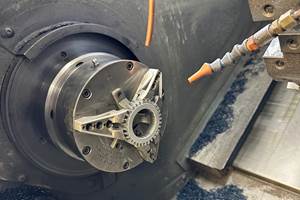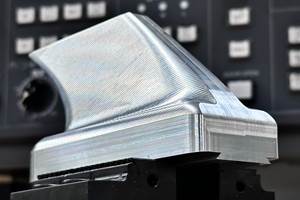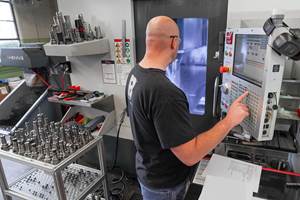Chuck Helps Restore Thin-Walled, Hardened Parts To Roundness
Heat treating can distort parts, especially round, thin-walled workpieces. During finish-turning, such components can conform to the shape of the chuck, only to spring back to an out-of-round state after clamping. Hardinge has developed a chuck with multiple gripping fingers to avoid this problem.
Share





Heat-treating a delicate, thin-walled workpiece in order to achieve the desired hardness often results in the part coming back тАЬout of round.тАЭ Although finish turning the part can provide some measure of roundness improvement, it is often not enough to meet specifications.
To address this problem, workholding solution provider Hardinge has developed a chuck designed specifically to tackle the problem of thin-walled, hardened parts that require high roundness accuracy. In a recent study, the company reported that a hard-turning process incorporating the chuck improved roundness approximately 10 times better than conventional workholding devices when used on the very same machines.
The problem arises during the heat-treat process, which uses time and temperature to alter the partтАЩs microstructureтАФand in turn, the mechanical properties of the steel. The thermal and residual stresses that develop during the carburization, harden/quench and temper processes distort the partтАЩs ID and/or OD, causing it to come back out-of-round.
A common strategy for addressing this problem is finish turning. During this operation, shops typically employ a conventional workholding device such as a jaw chuck, diaphragm chuck or step chuck with low gripping forces to avoid crushing or distorting the part. However, clamping the part can cause it to artificially тАЬround upтАЭ via distortion and conform to the shape of the chuck. When the part is released, it springs back to its original out-of-round state.
Unlike traditional workholding devices, however, HardingeтАЩs Shape-Compliant Chuck features multiple gripping fingers that act independently to grip the part тАЬas isтАЭ and avoid artificial rounding. To demonstrate the chuckтАЩs effectiveness, the company conducted a study comparing its performance to that of a conventional step chuck when hard-turning bearing races.
The bearing race used in the study was a 60-64 Rc through-hardened part with an OD measuring approximately 2.25 inches (57.15 mm). The machine of choice for the application, a Hardinge Quest turning center, features hydrostatic linear guideways and a Harcrete-reinforced cast iron base. Gripping the bearing race at the machineтАЩs lowest possible pressure setting with a conventional step chuck resulted in 1.35 times improved roundness.
However, when the bearing race was hard-bored on the same turning center with the Shape-Compliant Chuck, it maintained its out-of-round state during the cutting process, resulting in 10.9 times improved roundness. ID-to-OD concentricity was less than 0.00004 inch (1.01 micrometers). Speeds were maintained at 400 sfm at 940 rpm using CBN tooling and processed with two passes, each with a DOC of 0.003 inch (76.2 micrometers).
The particular model Shape-Compliant Chuck that was used in the study has eight gripping fingers that act independently to avoid artificially rounding the part. According to the company, other productivity benefits include rapid actuation, allowing more parts per hour; adjustable gripping forces; and high damping to reduce tool chatter and prolong tool life. Chuck models are available with an outer diameter gripping range from 0.5 to 4 inches (12.7 to 101.6 mm). They are manufactured to order by application according to applied force levels, operational speed range, grip points, jaw requirements, workpiece condition, accuracy levels and robot loading requirements.
Related Content
Chuck Jaws Achieve 77% Weight Reduction Through 3D Printing
Alpha Precision Group (APG) has developed an innovative workholding design for faster spindle speeds through sinter-based additive manufacturing.
Read MoreCustom Workholding Principles to Live By
Workholding solutions can take on infinite forms and all would be correct to some degree. Follow these tips to help optimize custom workholding solutions.
Read MoreMedical Shop Performs Lights-Out Production in Five-Axes
Moving to five-axis machining enabled this shop to dramatically reduce setup time and increase lights-out capacity, but success relied on the right combination of workholding and automation.
Read MoreNavigating Large-Scale CNC Machining: Suburban Tool’s Niche Strategy to Stay Competitive
Facing increasing competition from lower-cost imports, Suburban Tool made a move toward large-scale, in-house machining. By identifying a niche in large, precision angle plates and tombstones, the company has strengthened its ability to control quality and protect its reputation.
Read MoreRead Next
AMRs Are Moving Into Manufacturing: 4 Considerations for Implementation
AMRs can provide a flexible, easy-to-use automation platform so long as manufacturers choose a suitable task and prepare their facilities.
Read MoreLast Chance! 2025 Top Shops Benchmarking Survey Still Open Through April 30
Don’t miss out! 91╩╙╞╡═Ї╒╛╬█'s Top Shops Benchmarking Survey is still open — but not for long. This is your last chance to a receive free, customized benchmarking report that includes actionable feedback across several shopfloor and business metrics.
Read MoreMachine Shop MBA
Making Chips and 91╩╙╞╡═Ї╒╛╬█ are teaming up for a new podcast series called Machine Shop MBA—designed to help manufacturers measure their success against the industry’s best. Through the lens of the Top Shops benchmarking program, the series explores the KPIs that set high-performing shops apart, from machine utilization and first-pass yield to employee engagement and revenue per employee.
Read More






















